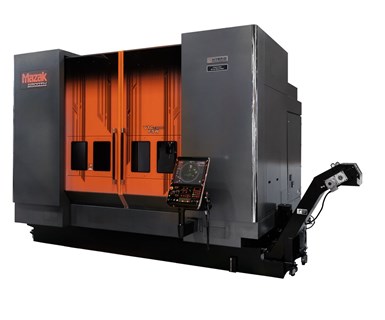Mazak's VTC-300C FSW Joins, Machines Alloys with Low Melting Points
A part of Mazak’s family of hybrid multitasking machining centers, the VTC-300C FSW combines milling capabilities with friction stir welding (FSW).
A part of Mazak’s family of hybrid multitasking machining centers, the VTC-300C FSW combines milling capabilities with friction stir welding (FSW). With a full traveling-column design, automatic toolchanger and 40-taper spindle in addition to the FSW package, this machine helps shops achieve reduced lead times and greater part accuracy while enabling novel methods for processing parts with stronger welds, the company says.

The machine’s FSW package uses a process that involves frictional heat and forging pressure to create full-penetration, defect-free welded joints said to be stronger than those made with conventional methods. Using a solid-state joining process with a non-consumable tool pin, the Mazak FSW head joins two metal plates without melting the workpiece. Commonly considered a forging process, FSW is described as well-suited for joining alloys with low melting points, including aluminum, copper and brass, among others.
The new welding technology complements the existing VTC-300C machine platform, which delivers a standard 15,000-rpm, 30-hp, 40-taper spindle capable of handling a variety of metalcutting applications. Additionally, the machine and way cover designs have been enhanced to provide 1,574-ipm rapid feed rates on all axes. The fixed 78.74" × 30" table provides process flexibility for a range of applications, while an optional center partition can divide the work envelope into two separate work zones to allow the machine to be in cycle in one area while an operator loads, unloads or sets up a part in the other. The machine’s X-, Y- and Z-axis travels measure 65.35", 30" and 25.6", respectively.
The VTC-300C FSW also features Mazak’s Mazatrol SmoothG CNC, which is designed to ease programming for highly complex parts. A large, 19" touchscreen display presents all of the critical machine data within a single page view, while the tilt control panel allows for optimum positioning based on operator height.
Related Content
-
A New Milling 101: Milling Forces and Formulas
The forces involved in the milling process can be quantified, thus allowing mathematical tools to predict and control these forces. Formulas for calculating these forces accurately make it possible to optimize the quality of milling operations.
-
Understanding Swiss-Type Machining
Once seen as a specialty machine tool, the CNC Swiss-type is increasingly being used in shops that are full of more conventional CNC machines. For the newcomer to Swiss-type machining, here is what the learning curve is like.
-
Volumetric Accuracy Is Key to Machining James Webb Telescope
To meet the extreme tolerance of the telescope’s beryllium mirrors, the manufacturer had to rely on stable horizontal machining centers with a high degree of consistency volumetric accuracy.













